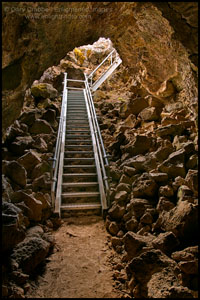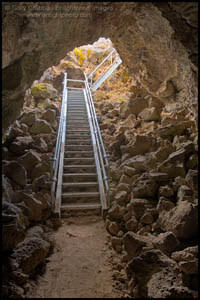Picture(s): Lava Tube Cave Entrance, Lava Beds National Monument, Modoc County, California.


Those people that know me and have seen my image postings around the internet may have seen many of my postings contain the phrase, “No HDR”. The only reason I posted that, and have mentioned before, is that I’d get so many comments from people saying something like , “Wow, great use of HDR.” I finally just started posting the No HDR comment to head those other comments off at the pass, so to speak, especially since I didn’t ‘do’ HDR. In fact, it was only a couple months ago when I made my first HDR image.
It’s not that I’m against HDR, by which I mean the automated computer process of blending multiple exposures. I’ve seen some very good HDR, and some extremely horrid HDR. On the good ones, you can barely tell HDR was used, while the bad ones have more halos than a pack of angry angels. For myself, I never used HDR because having grown up in the film era, I was just really good at pointing my camera at places where I know I could control the contrast range within an image. If there were dark shadows, I was OK with them being dark.
However, on my last trip, I encountered several instances where there was just no possible way any single exposure could handle the range of contrast. For example, the above image was taken inside the entrance to a cave at a point were bright light met extreme shadow. In fact, twenty feet further down the tube you could open a roll of film without fear of exposing it – dark. I shot this image with HDR in mind, shooting 8 frames in 2/3rd stop increments.
After I processed it, I decided to test out an alternate process of extending dynamic range on the same image, namely by doing a manual blend. Rather than having the computer do everything automated, I chose three of the eight frames, and using layer masks worked my way out from lightest to darkest.
When all was said and done, I much preferred the look and feel of my manually blended shot over the HDR image. Both shots have Extended Dynamic Range (EDR), but for me the HDR just didn’t turn out as well as the manual blend; it felt to0 flat and ‘processed’. You may feel differently – and that’s OK. Just so you know, the Manual Blend is on the Left & the HDR on the Right.

The image on the left is clearly superior. The right one lacks contrast and has poor color. This is not an HDR problem, but a tone mapping problem. I assume you used Photoshop, which has poor tone mapping. Tone mapping is not “automated”, but done by sliding sliders. Supposedly, Photomatix is better, but personally I also prefer to use manual blending.
Gary,
You proved a point here. Automated HDR is useful for some applications and situations, but not for everything. A photographer will still need to “get their hands dirty” to have the most control over their work. Layer masking and other “manual” processes can be long, tedious work, but in the end it is you who have chosen which parts to mask and to what degree, along with any other treatments and adjustments you apply.
Regardless of the number of ‘controls’ available, automated anything still relies upon the programming and formulas of someone else to create a finished product that, in reality, isn’t completely your own. In the “new” digital age, we’re all maybe looking for the “one pill” that does it all without having to exercise, but if we rely on automated processes how can we call what we do ‘art’?
I think what we can do digitally is great, but it’s easy to get caught up in the whiz-bang of it all. This reminds me of an appropriate quote. Seems this problem never ends.
“The very richness of control facilities often acts as a barrier to creative work. The fact is that relatively few photographers ever master their medium. Instead, they allow the medium to master them and go on an endless squirrel cage chase from new lens to new paper to new developer to new gadget, never staying with one piece of equipment long enough to learn its full capacities, becoming lost in a maze of technical information that is of little or no use since they don’t know what to do with it”
–Edward Weston, 1930, Camera Craft Vol 37 No 7: pp 313-20
The image on the right looks more flat to me, the one on the left looks more contrasty and more like what would normally come out of a camera in my opinion. An interesting image regardless.
I’m with you, Gary. I don’t do HDR, but I do frequently blend bracketed exposures in post. To my way of thinking, this is equivalent to using a GND on the camera, except that it gives me more control over the blend.
Dan
Hi Gary,
Agree. I used manual blends a lot, and find them very useful. Great article
The left-hand image is the clear winner here.
I use HDR as a regular part of my workflow, and one thing to be careful of is to not lose the mid-tone contrast as you have in the right hand image. Some images are more susceptible than others, and on those images, manual blending is probably a better choice. A skill I’ve yet to learn.
Great comparison!
I find the results I get with an ultra-simple automated Lightroom plug-in called Enfuse to be excellent. I suspect that many HDR wow-factor fans would find the results far too understated to be of interest.
I prefer the left image by a lot.
I tend to do manual blends for my HDR work as well – looks more natural.
Nice comparison. The image on the left is clearly better. One of the problems with blending exposures, whether with HDR or manually in Photoshop, is that you can lose local contrast – which clearly happened in the right-hand photo. Your manual blend retained this local contrast. I’ve compared HDR and manual Photoshop blends in many of my own images, and usually like the Photoshop blends better, but I’ve encountered a few exceptions. The effects of HDR are hard to predict, but are sometimes better. Like John Wall above, I recently discovered LR Enfuse and have been pleasantly surprised by the excellent results. It’s not HDR, but an automated blending algorithm. Photomatix also has an exposure blending mode, but I’ve been more impressed with LR Enfuse.
I’ll go with the left one too. But I will add that on the HDR’s that I’ve done, I always process them conservatively as you did on the right and then bring it into Photoshop and make contrast adjustments there. I bet you could make the right one look like the left one (possibly better) with a extra few minutes of processing.
I put ‘No HDR’ on every Flickr upload for the reasons you mention, but the problem is that Flickr indexes all words in the description. So if you search for ‘HDR’ and order by interestingness, I have 4 on the first page out of 1.5 million and dozens on the first several pages. If you enter ‘california HDR’ I have 31 of the top 35. Then I get about 10 people every day saying ‘Nice HDR!’
Now that is frustrating!
Patrick
I agree with you. I’ve tried doing HDR with not much success. I had been doing manual blends before the HDR hype skyrocketed and like you, have been horrified by some of the results. I still prefer doing manual blends and also prefer yours as well.
Although I have been trying HDR more lately – I couldn’t agree more with your points here Gary. It is not always a successful method of processing. On my recent Alaska trip, I shot several scenes with the intention of processing them as HDR. However, for many of them – I liked one of the single straight exposures much better than the blended one.